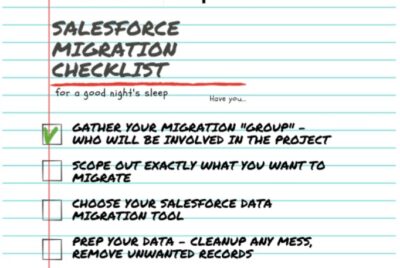Do You Need Salesforce Migration Services?
Although the invention of the printing press was one of the most influential developments in communication, it’s easy to take modern printing technology for granted.
After all, inkjet printing has been around since the 1950s, and printed documents are so ubiquitous that we seldom stop to question the process behind this foundational technology. Printers don’t write words the same way humans do. While word processors write one letter at a time, inkjet printers simultaneously print every word on a line from top to bottom.
Although the meaning of the words stays the same, a middle step is required to transform the information from one format (a digital document) to another (the printed page).
This translation of information isn’t unique to printing technology. We translate information between human users who speak different languages, computers that use different machine languages, and platforms that use information differently. Salesforce is one of those information platforms, and Salesforce migration is the middle step needed to translate that data into a format that other platforms can utilize.
What Are Salesforce Migration Services?
The data you collect in Salesforce has the power to provide powerful insights for your organization. But to access those insights, you must put data into a format you can use.
Salesforce migration is moving data from Salesforce into a singular location. Putting data from all your different data sources into a central repository is the only way to make analyses that include the full picture of your operations, but it also creates unique challenges. The source of your data influences how software reports and formats your data, meaning that data from different sources will take different shapes.
Decision-makers rely on quality data, so Salesforce migration is essential to the business.
Because Salesforce migration is a technical process with room for error, companies like Rainmaker that specialize in Salesforce managed services help users bridge the gap between their business needs and Salesforce’s platform. These migration services help users make sense of the data coming from Salesforce by integrating it with their existing data.
Alternately, Salesforce migration may flow in the opposite direction—for example, when moving from another CRM to Salesforce, you will need to migrate data into Salesforce rather than out of it—but the same concepts and steps will be consistent with migration in either direction.
Salesforce Migration Process
Because Salesforce data can include hundreds of mapped fields, it’s important to follow a consistent process. Diligently adhering to these steps ensures that data correctly migrates because once data incorrectly integrates, it’s hard to get the cat back in the bag.
Step 1. Preparation
As the saying goes, “an ounce of prevention is worth a pound of cure.” Being painstaking about the preparation stage of your Salesforce migration is a worthwhile investment. Before beginning your migration, answer the following questions:
- Who will be involved in this process?
- What data am I going to migrate?
- What format do I need data to be in?
- What Salesforce migration service will I use?
- What is my migration timeline?

Step 2. Data Selection
In the preparation stage, you identified which data you are migrating. In the data selection stage, you will select the sources of that data. You use data like vendor contact information, sales invoices, contract status, etc., across your organization. When your organization stores the same data across decentralized storage locations, identifying the “true” source of truth is not always straightforward.
For example, when a customer notifies their sales rep that their phone number has changed, the sales and marketing department may change the customer’s phone number in their CRM, but the accounting department may have the old phone number stored in their accounting software. Which one of these phone numbers is the “real” number?
Selecting what kinds of data you will bring from Salesforce or other sources (or alternately, from other sources to bring into Salesforce) depends on how your company has structured its document management. Generally, Salesforce will store information relating to sales processes, while you will store information relating to customer activity in the backend.

Step 3. Data Mapping and Cleansing
Bringing data from decentralized storage into a central repository is not simply a matter of copy and paste. Not only are the sources and contents of your data complex, but the relationship between data fields is also complex. Bringing data into a central location is only half the battle—making sense of that data requires understanding how disparate pieces of information relate to each other.
Data fields in Salesforce use a unique Record ID to avoid confusion caused by similarly named fields. Mapping and cleansing this data involves structuring data relationships and building sharing models, discarding redundant or outdated information, and identifying the metadata that you will use for data mapping.
Step 4. Migration
Once you’ve planned, selected, mapped, and cleansed your data, you’re ready to begin the migration. This step involves transferring the actual data between Salesforce and other sources. The time this process will take depends on the volume and complexity of your data, as well as the method you’ve selected for the migration.
Solving Salesforce Migration Challenges
The process of Salesforce migration is complex and requires deep knowledge of data relationships, data storage, document management, the specifics of Salesforce services, and the specifics of the data formats and fields your other platforms use. It’s only natural that the biggest challenge facing Salesforce migration is the possibility of inexperience, misconception, or simple mistakes that human error brings in.
Because managing this migration is such a complicated task that involves a depth of specialized knowledge, Rainmaker offers Salesforce migration services that solve many of the challenges of this transition.
Migrating data into and out of Salesforce is only one of the challenges of managing Salesforce services. Take the guesswork out of your Salesforce management by trusting the experts at Rainmaker. Schedule a meeting today to learn how Rainmaker can revolutionize your Salesforce migration, managed services, and more.






